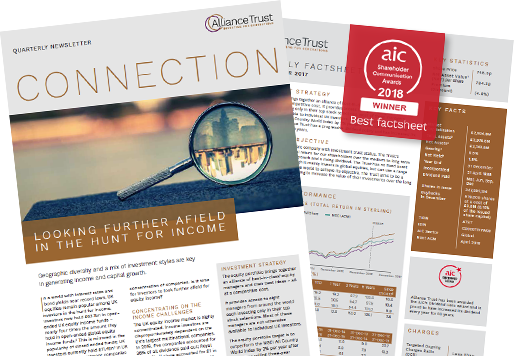Tackling climate change: our commitment to net zero
Our investment manager, Willis Tower Watson (WTW), has committed to managing our portfolio in a way that is consistent with getting to net zero greenhouse gas emissions by 2050 at the latest. WTW will look to manage this in line with the goals of the Paris Agreement, with a trajectory that is consistent with at least a 50% reduction between 2015 and 2030, but starting from 2017 when they took on our mandate.
It is a 30-year journey with no magic wand to wave to accelerate progress, but WTW have a strong ESG framework in place for the Company to help us get there. This framework includes hiring stock pickers who are strong on ESG integration, measuring the portfolio’s weighted-average carbon intensity (among other relevant metrics), challenging the Stock Pickers on their choice of holdings where necessary and actively engaging with companies to accelerate the climate transition, including using the services of EOS at Federated Hermes, who are independent engagement and stewardship specialists.
These measures have already ensured that our holdings have averaged much lower weighted-average carbon intensity than the benchmark, although these numbers can change quickly and the overall path is more important than a snapshot in time. “When challenging the Stock Pickers on their portfolios we dig much deeper into their understanding of the true climate value-at-risk at the companies they are invested in rather than just the current emissions, “said Craig Baker, Chairman of the Alliance Trust Investment Committee and Global Chief Investment officer of WTW.
What are greenhouse gas emissions?
Greenhouse gases are gases in the Earth’s atmosphere that absorb and emit heat from the sun, causing a ‘greenhouse’ effect. The most common are water vapour (H2O), carbon dioxide (CO2), methane (CH4), nitrous oxide (N2O), and ozone (O3).
Greenhouse gases are crucial in maintaining life as we know it: without them, the average temperature on Earth, currently around 15ºC, would be around -18ºC.
But the problem is that the explosion of industry, travel, commercial farming and other human activities since around 1750 has led to an increased concentration of greenhouse gases in the atmosphere, and in particular a rise of around 45% in carbon dioxide levels. That rise means the planet is getting warmer, with potentially catastrophic effects on sea levels, weather patterns and ecosystems.
Since pre-industrial times, the temperature has risen by around 1ºC, with around two thirds of that happening in the past few decades. If that trend continues unabated, global warming is set to reach 1.5ºC above pre-industrial levels between 2030 and 2052, and considerably more by 2100.
That may sound like a pretty small number, but a rise of that magnitude would be enough to tip the balance and start to trigger irreversible damage to the planet’s natural systems.
How is WTW defining net zero exactly?
Our definition of net zero is the reduction in the greenhouse gas emissions of our investment portfolios, defined as Scope 1 and 2 emissions per $ invested, to zero by 2050 at the latest. In defining net zero we also envisage a world where increases in global average temperatures have been limited to 1.5ºC or less, with limited reliance on Negative Emissions Technologies such as natural sequestration, carbon capture and storage and direct air capture. The implication of this is that we aim to take limited “credit” for emissions mitigated/avoided by investments in our portfolio and target the lowest feasible level of residual emissions.
What are scope 1, 2 and 3 emissions?
The Greenhouse Gas Protocol, which provides the most widely used international accounting tools for tracking climate change, has split greenhouse gas emissions by organisations into three categories or ‘scopes,’ according to their source.
Scope 1 covers direct emissions from a business, or those under its control, for example emissions from boilers and leaks from air conditioning units on the premises, or exhaust from fleet vehicles.
Scope 2 covers indirect emissions created in the production of electricity, heating, cooling and steam bought and used by the organisation.
Scope 3 covers any other indirect emissions as a consequence of the organisation’s activities. These usually account for the greatest share of the business’ total greenhouse gas emissions (its carbon footprint); they can include emissions from the likes of business travel, purchased goods and services, employee journeys to work, and waste disposal.
Is there not overlap in scope 1, 2 and 3 emissions in a portfolio?
In the short and medium term, there will be some overlap in a portfolio, however that overlap is significantly reduced if and when the entire economy is successful in moving to net zero, particularly with a limited reliance on Negative Emissions Technologies. As an example of a current source of overlap, some of the scope 2 emissions of the non-energy companies in a portfolio will overlap with the scope 1 emissions of the energy companies in that portfolio (and this overlap will be more extreme for scope 3). However, it is important to note that there are state-owned energy companies that will inevitably not be in the portfolio and could produce much of the scope 2 emissions of the remainder of the portfolio.
Does that mean WTW will ignore Scope 3 emissions completely?
No. Ultimately in order to see a transition to a net zero economy it is important that we engage with companies to reduce their emissions across scope 1, 2 and 3, recognising again that not all of those Scope 3 emissions will overlap with other companies in the portfolio.
What is the Paris Agreement and who has signed up to it?
The Paris Agreement is a legally binding international agreement designed to try and limit greenhouse gas emissions and manage wider climate change. It was signed by 195 countries and the European Union, following the COP 21 (Conference of Parties) convention in 2015.
Why is it in place?
The stated aim of the Agreement is to limit global warming to well below 2ºC and preferably below 1.5ºC above preindustrial levels. That involves reaching a peak in greenhouse gas emissions as soon as possible, with the target of a ‘climate-neutral’ or ‘net zero emissions’ world by mid-century.
The Paris Agreement also aims to ensure that globally we are better able to adapt and more resilient in the face of potential problems associated with climate change - for instance, widespread flooding, fires, drought or violent storms.
How do WTW expect to reduce carbon emissions in the Alliance Trust portfolio?
WTW believe that the transition to net zero should be achieved via a combination of decarbonisation in the short to medium term and investment in long-term climate solutions. WTW expect that engagement is likely to be more effective in decarbonising the system than exclusions, but also recognises that exclusions will be necessary at times where engagement cannot solve the problem.
Why is the trajectory to net zero emissions at least as important as the target date?
There may be a tendency to think of an earlier “net zero date” as a proxy for a more ambitious target. We would however note that “net zero 2050” is necessary shorthand for the global decarbonisation pathway that is required in order to avoid overshooting the remaining carbon budget that is consistent with limiting global average temperature increases to 1.5 degrees or below. Given this, WTW believe that the trajectory of carbon emissions, in particular over the next decade, is more material than the chosen end point.
Why is engagement better than divestment?
It’s straightforward for professional investors such as fund managers to take the ‘divestment’ route, whereby they simply refuse to own shares or sell existing holdings in those companies that don’t meet the stated climate change requirements at that moment in time. Many funds have taken this path in regard to fossil fuel companies.
But the fact is that an oil producer won’t drill any fewer wells because a fund manager decides not to invest in it. It can be much more effective for professional shareholders to proactively engage with such businesses, to pressurise, influence and support them in reducing greenhouse gas emissions.
Indeed, this kind of shareholder engagement can shape a company’s behaviour more widely, influencing its attitude and policy towards employees, small shareholders, the companies that supply it and the community in which it operates, and generally helping it to be a ‘better’ company. That process is known as ESG engagement.
In addition, shareholders can then benefit from any positive impact that has on the company’s share price as a result of this change.
Why does investing in this way increase expected returns and reduce risk?
Various studies have established that businesses with better ESG credentials have on average a lower chance of going bankrupt, more stable cash flows, and greater resilience to external ESG upsets.
Following on from that, further research has found that when professional shareholders engage with companies to try and improve the way they operate, those companies become less risky for investors. In other words, share prices are likely to be less volatile when markets are choppy, and less likely to fall generally. Environmental changes have the biggest effect in reducing a company’s risk.
But there’s also empirical evidence that businesses that do well in terms of ESG factors tend to be good-quality, robust, well-managed companies run with long-term perspective rather than for short-term gains – and that such companies are able to outperform their peers over the long term.
Why are we making this net zero commitment?
Importantly we are doing this for investment reasons – we think it will lead to better risk-adjusted returns. In addition, however, it also clearly has positive ‘impact’ on wider society and the planet.
But won’t there be times when pricing is such that this looks less of a good investment decision?
Being strategically ahead of a net zero transition will, in our opinion, significantly improve risk-adjusted returns.
However, it needs to be recognised that it is not in investors’ financial interests to force ourselves to always be ahead of the pathway to net zero regardless of market pricing. The important things are the destination and the overall trajectory, rather than the position at every single point along the path to net zero. So there will be times that we are ahead and times that we are behind but this does not diminish from the main goals.
How will we monitor adherence to the pledge over time?
WTW recognise that it is important not to focus solely on a single metric in assessing our progress towards our net zero goals. Different metrics have strengths and weaknesses and analytics and data in the climate space are rapidly evolving. The logical measurement framework for targets is therefore an ‘impact measurement dashboard’ which presents a balanced view of all the metrics that are inputs to our portfolio decisions.
In particular, it is important to note that current emissions are not always the best measure of adherence to the trajectory between now and 2050. The trajectory that a company is on is at least as important as today’s emissions starting point, as is their role in helping the wider economy achieve net zero and of course the likely impact of all of this on their particular share price (noting that some companies find it easier than others to pass on an effective carbon tax to consumers).
View more information on Willis Towers Watson committment to net zero.
View our latest responsible investment report






